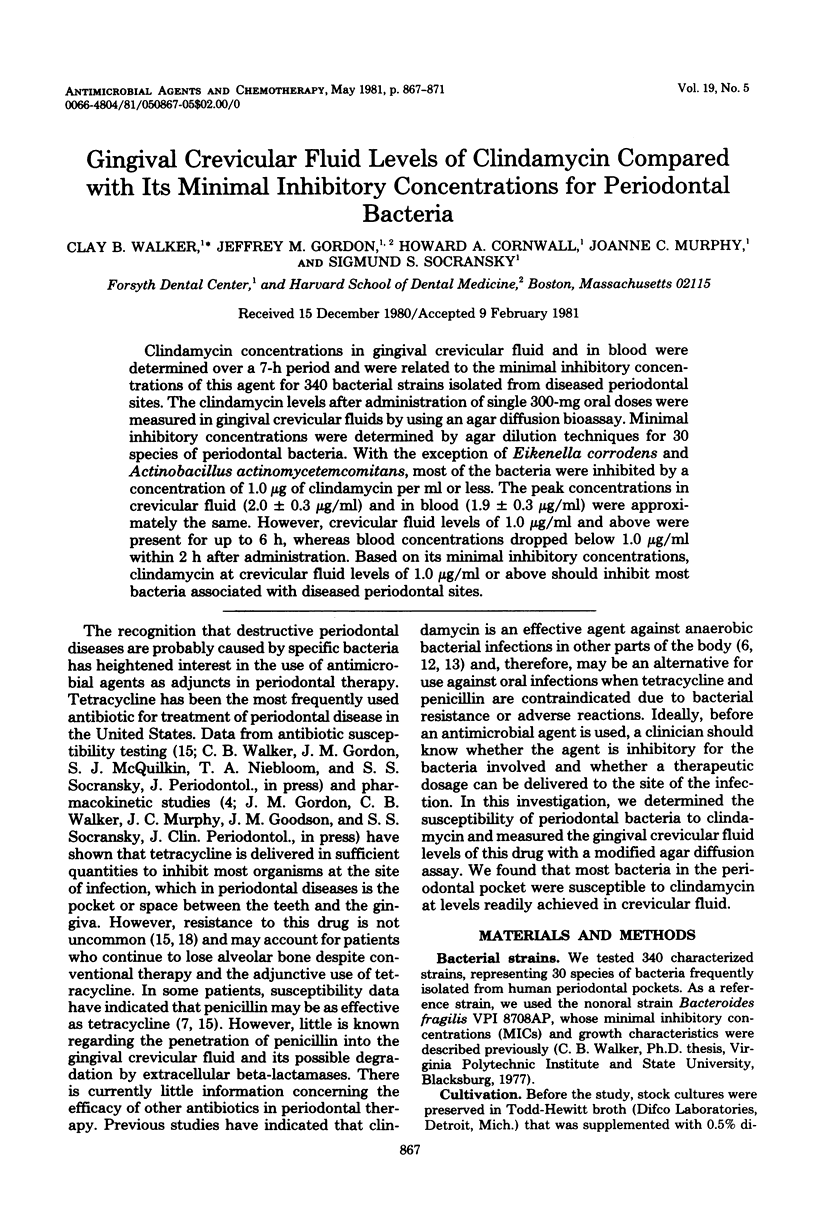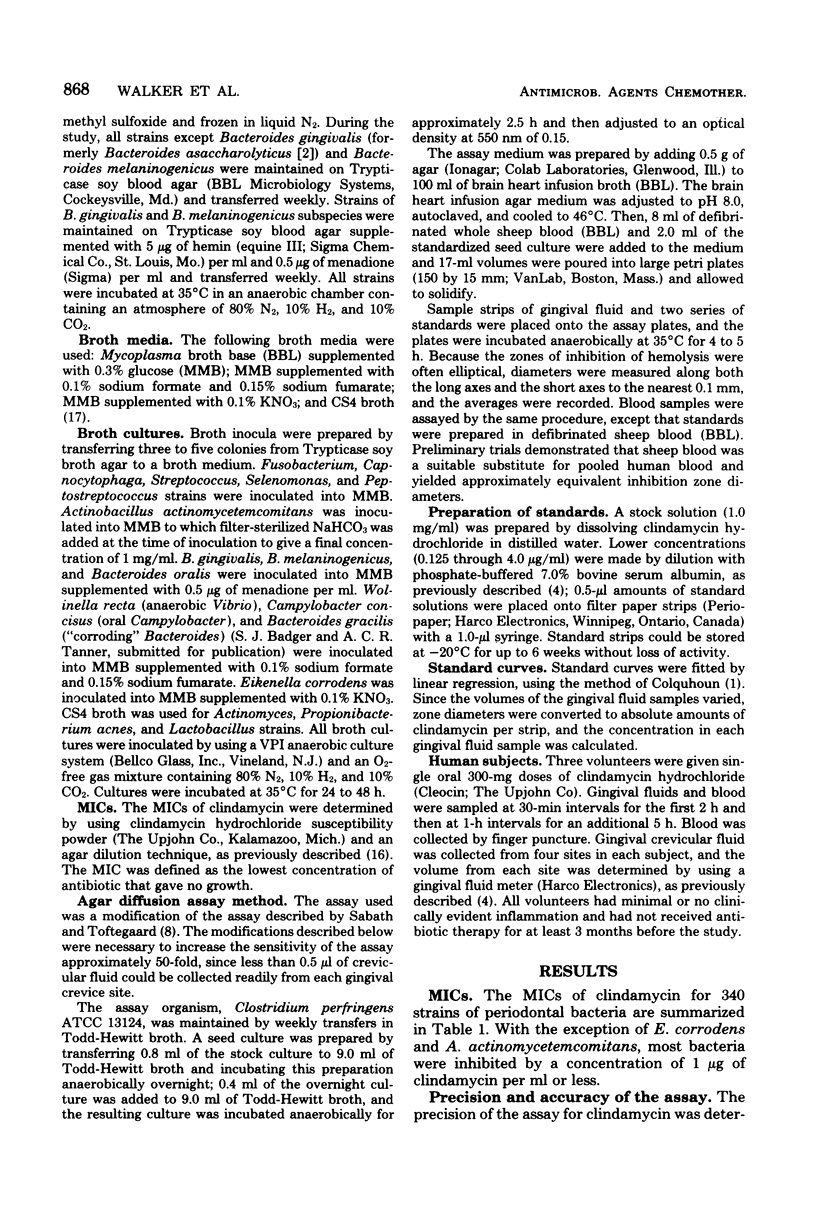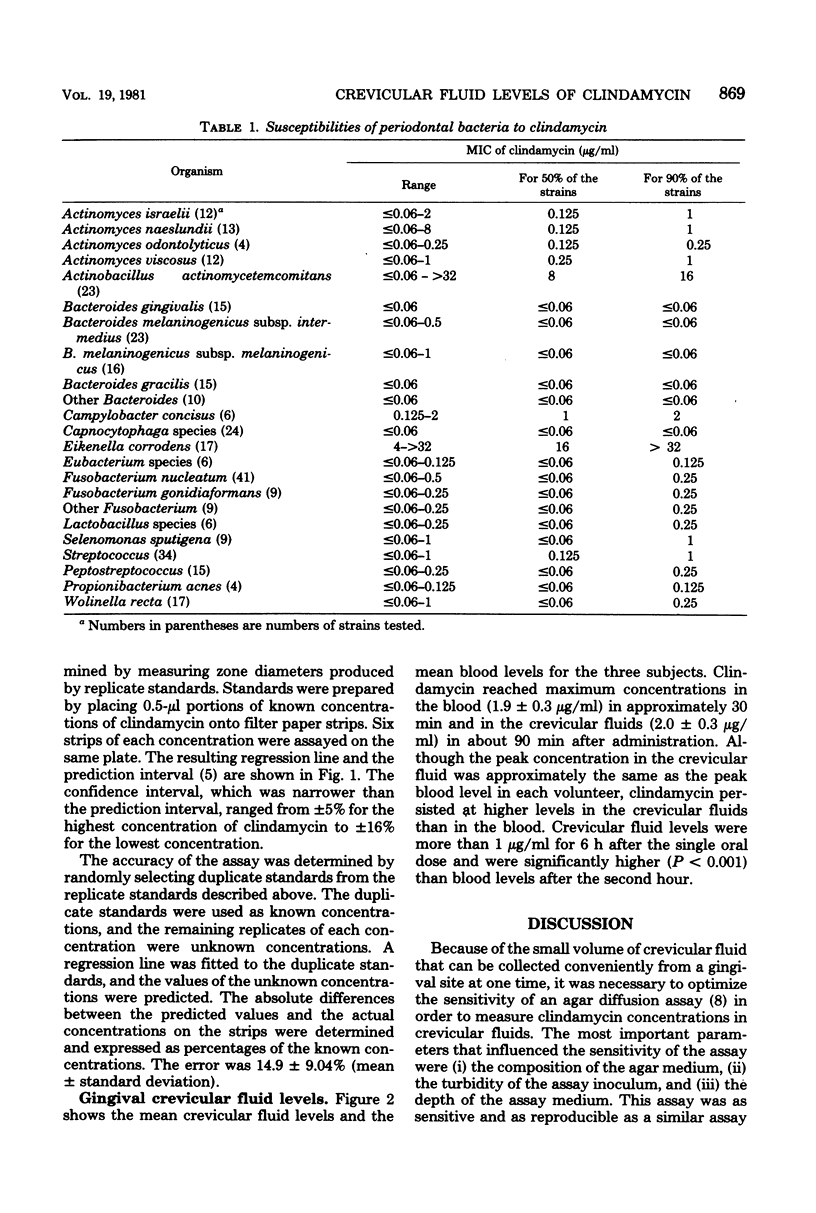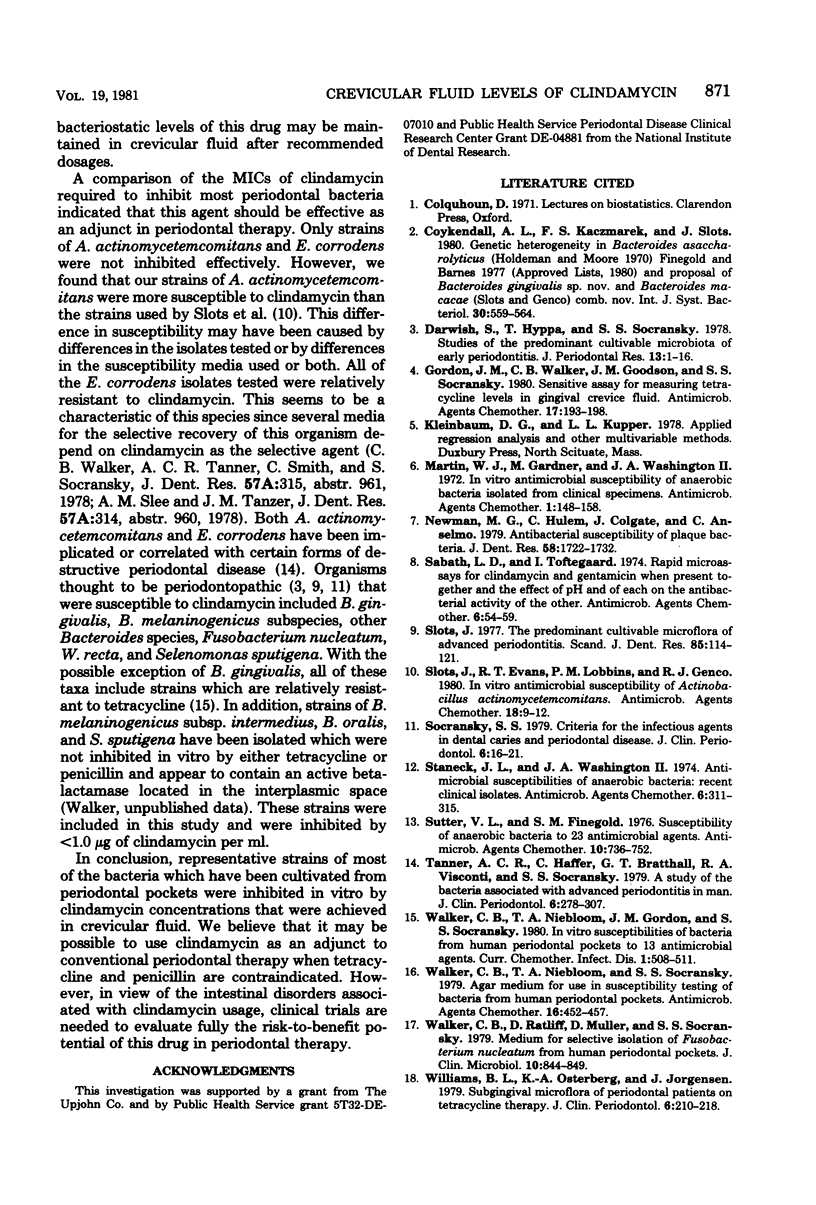Abstract
Clindamycin concentrations in gingival crevicular fluid and in blood were determined over a 7-h period and were related to the minimal inhibitory concentrations of this agent for 340 bacterial strains isolated from diseased periodontal sites. The clindamycin levels after administration of single 300-mg oral doses were measured in gingival crevicular fluids by using an agar diffusion bioassay. Minimal inhibitory concentrations were determined by agar dilution techniques for 30 species of periodontal bacteria. With the exception of Eikenella corrodens and Actinobacillus actinomycetemcomitans, most of the bacteria were inhibited by a concentration of 1.0 microgram of clindamycin per ml or less. The peak concentrations in crevicular fluid (2.0 +/- 0.3 microgram/ml) and in blood (1.9 +/- 0.3 micrograms/ml) were approximately the same. However, crevicular fluid levels of 1.0 micrograms/ml and above were present for up to 6 h, whereas blood concentrations dropped below 1.0 micrograms/ml within 2 h after administration. Based on its minimal inhibitory concentrations, clindamycin at crevicular fluid levels of 1.0 micrograms/ml or above should inhibit most bacteria associated with diseased periodontal sites.
Full text
PDF




Selected References
These references are in PubMed. This may not be the complete list of references from this article.
- Darwish S., Hyppa T., Socransky S. S. Studies of the predominant cultivable microbiota of early periodontitis. J Periodontal Res. 1978 Jan;13(1):1–16. doi: 10.1111/j.1600-0765.1978.tb00149.x. [DOI] [PubMed] [Google Scholar]
- Gordon J. M., Walker C. B., Goodson J. M., Socransky S. S. Sensitive assay for measuring tetracycline levels in gingival crevice fluid. Antimicrob Agents Chemother. 1980 Feb;17(2):193–198. doi: 10.1128/aac.17.2.193. [DOI] [PMC free article] [PubMed] [Google Scholar]
- Martin W. J., Gardner M., Washington J. A., 2nd In vitro antimicrobial susceptibility of anaerobic bacteria isolated from clinical specimens. Antimicrob Agents Chemother. 1972 Feb;1(2):148–158. doi: 10.1128/aac.1.2.148. [DOI] [PMC free article] [PubMed] [Google Scholar]
- Newman M. G., Hulem C., Colgate J., Anselmo C. Antibacterial susceptibility of plaque bacteria. J Dent Res. 1979 Jul;58(7):1722–1732. doi: 10.1177/00220345790580071401. [DOI] [PubMed] [Google Scholar]
- Sabath L. D., Toftegaard I. Rapid microassays for clindamycin and gentamicin when present together and the effect of pH and of each on the antibacterial activity of the other. Antimicrob Agents Chemother. 1974 Jul;6(1):54–59. doi: 10.1128/aac.6.1.54. [DOI] [PMC free article] [PubMed] [Google Scholar]
- Slots J., Evans R. T., Lobbins P. M., Genco R. J. In vitro antimicrobial susceptibility of Actinobacillus actinomycetemcomitans. Antimicrob Agents Chemother. 1980 Jul;18(1):9–12. doi: 10.1128/aac.18.1.9. [DOI] [PMC free article] [PubMed] [Google Scholar]
- Slots J. The predominant cultivable microflora of advanced periodontitis. Scand J Dent Res. 1977 Jan-Feb;85(2):114–121. doi: 10.1111/j.1600-0722.1977.tb00541.x. [DOI] [PubMed] [Google Scholar]
- Socransky S. S. Criteria for the infectious agents in dental caries and periodontal disease. J Clin Periodontol. 1979 Dec;6(7):16–21. doi: 10.1111/j.1600-051x.1979.tb02114.x. [DOI] [PubMed] [Google Scholar]
- Staneck J. L., Washington J. A., 2nd Antimicrobial susceptibilities of anaerobic bacteria: recent clinical isolates. Antimicrob Agents Chemother. 1974 Sep;6(3):311–315. doi: 10.1128/aac.6.3.311. [DOI] [PMC free article] [PubMed] [Google Scholar]
- Sutter V. L., Finegold S. M. Susceptibility of anaerobic bacteria to 23 antimicrobial agents. Antimicrob Agents Chemother. 1976 Oct;10(4):736–752. doi: 10.1128/aac.10.4.736. [DOI] [PMC free article] [PubMed] [Google Scholar]
- Tanner A. C., Haffer C., Bratthall G. T., Visconti R. A., Socransky S. S. A study of the bacteria associated with advancing periodontitis in man. J Clin Periodontol. 1979 Oct;6(5):278–307. doi: 10.1111/j.1600-051x.1979.tb01931.x. [DOI] [PubMed] [Google Scholar]
- Walker C. B., Niebloom T. A., Socransky S. S. Agar medium for use in susceptibility testing of bacteria from human periodontal pockets. Antimicrob Agents Chemother. 1979 Oct;16(4):452–457. doi: 10.1128/aac.16.4.452. [DOI] [PMC free article] [PubMed] [Google Scholar]
- Walker C. B., Ratliff D., Muller D., Mandell R., Socransky S. S. Medium for selective isolation of Fusobacterium nucleatum from human periodontal pockets. J Clin Microbiol. 1979 Dec;10(6):844–849. doi: 10.1128/jcm.10.6.844-849.1979. [DOI] [PMC free article] [PubMed] [Google Scholar]
- Williams B. L., Osterberg S. K., Jorgensen J. Subgingival microflora of periodontal patients on tetracycline therapy. J Clin Periodontol. 1979 Aug;6(4):210–221. doi: 10.1111/j.1600-051x.1979.tb01923.x. [DOI] [PubMed] [Google Scholar]


